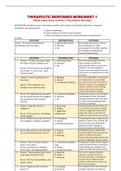Other
[Psychiatric Nursing] Therapeutic Responses Worksheets with Answers
- Course
- Psychiatric Nursing
- Institution
- Brock University ( )
In this document, it contains two worksheets with answers. The worksheets are both about therapeutic communication/responses. Moreover, the worksheet also contains rationale/explanation for each answer.
[Show more]



